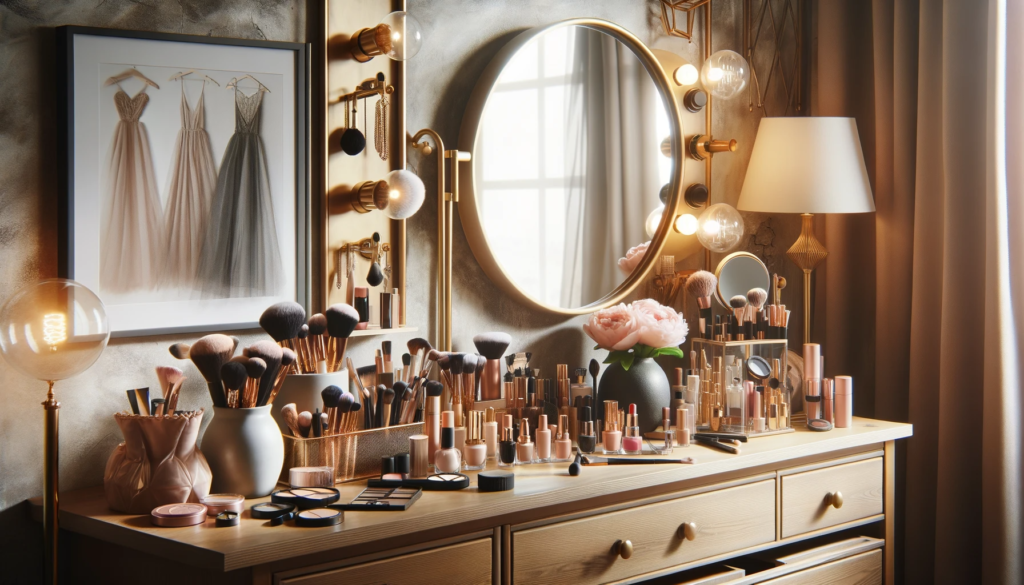Welcome to the world of cosmetology, a realm where art and science blend seamlessly to create beauty and confidence. As a seasoned cosmetologist, I’ve spent years mastering the craft of hair styling, makeup artistry, and skincare. Each day in this field is a new adventure, filled with its own set of challenges and triumphs. In this blog, I want to take you behind the scenes to share the secrets and stories that shape our daily work.
Cosmetology goes beyond being a job; it’s a learning experience fueled by passion. It involves more, than finding the hair care routine mastering makeup techniques or understanding the complexities of skincare. There’s always something to discover. It’s not about the methods and products; it’s about connecting with people understanding their unique needs and bringing them joy by helping them look and feel their best.
In the following sections we will explore the intricacies of hair care unravel the secrets behind flawless makeup application delve into the essentials of maintaining skin and even peek into the business side of the beauty industry. From debunking misconceptions to sharing insider tips from professionals in the field we will cover everything you need to know. So whether you aspire to be a cosmetologist yourself have an interest in beauty. Are simply curious about what happens behind the scenes in salons and spas. This blog is tailored for you.
Come join me on this journey through the realm of cosmetology where each revelation serves as a lesson, in beauty, artistry and self care.
Hair Care Secrets

1.1: The Truth About Daily Hair Care
When it comes to hair care, there’s a sea of information out there, and it can be tough to distinguish fact from fiction. As a professional cosmetologist, I’ve seen the impact of common hair care myths on clients’ hair health and I’m here to set the record straight.
Myth vs. Reality: One of the most pervasive myths is that washing your hair daily is a must. However, this can actually strip your hair of its natural oils, leading to dryness and damage. The key is understanding your hair type. For instance, oily hair might require more frequent washing, while dry or curly hair might thrive with less.
Personalized Hair Care Tips: Everyone’s hair is unique, and your hair care routine should be too. A product that works wonders for one person might not be suitable for another. It’s essential to identify your hair type – be it oily, dry, curly, straight, fine, or thick – and tailor your hair care routine accordingly. For instance, those with fine hair might opt for lightweight, volumizing products, while those with curly hair might prefer hydrating and curl-defining products.
1.2: Behind the Salon Chair
As we continue our journey into the world of hair care, let’s peek behind the curtain of a cosmetologist’s day-to-day experiences. Here, I’ll share some insider tricks and what we, as professionals, wish our clients knew about hair styling and coloring.
Styling Secrets: One of the best-kept secrets in hair styling is the power of the right tools and products. For instance, using a heat protectant before any heat styling is crucial to prevent damage. Also, when it comes to tools like curling irons or straighteners, quality matters. Investing in good tools not only gives better results but also ensures less harm to your hair in the long run.
Coloring Wisdom: When it comes to hair coloring, the most important advice I can give is to have realistic expectations and patience. Achieving that perfect shade can take time, especially if you’re going for a significant change. Also, maintenance is key. Regular touch-ups and using color-safe shampoos and conditioners can make a world of difference in how your color looks and how long it lasts.
Finally, communication with your stylist is crucial. Be clear about what you want, but also be open to their professional advice. After all, we’re here to make sure you leave the salon looking and feeling your best.
Makeup Mysteries Unveiled

2.1: Foundation Fundamentals
The foundation of any great makeup look is, quite literally, the foundation. This staple product can make or break your look, so understanding how to choose and apply it is crucial.
Choosing the Right Product: Foundation comes in various forms – liquid, powder, cream, and more. The key is to choose a type that complements your skin type. For oily skin, a matte, oil-free liquid or powder foundation works best. For dry skin, a hydrating liquid or stick foundation can provide moisture and a dewy finish. Additionally, shade matching is critical. Always test a foundation on your jawline in natural light to find the perfect match for your skin tone.
Application Techniques: The way you apply foundation can vastly affect its appearance and longevity. For a natural look, use a damp beauty sponge to gently press the foundation into the skin. For fuller coverage, a brush can provide a more polished finish. Remember, less is often more with foundation; start with a small amount and build up as needed.
2.2: Eye Makeup Essentials
Eye makeup can be transformative, but it also requires understanding your unique features and how to enhance them. Here, we’ll discuss techniques for different eye shapes and tips for ensuring your eye makeup stays put all day.
Techniques for Different Eye Shapes: Every eye shape has its own set of flattering techniques. For example, those with hooded eyes can use matte eyeshadows to create depth and give the illusion of a more pronounced crease. People with almond eyes have a versatile shape that works well with most styles, but winged eyeliner can particularly accentuate their natural elegance. It’s all about playing to your strengths and experimenting to see what works best for you.
Long-lasting Wear Tips: One of the biggest challenges with eye makeup is ensuring it lasts. Always start with a primer to create a smooth base and increase the longevity of your eyeshadow. For eyeliner, consider waterproof formulas, especially if you have oily lids or live in a humid climate. Finally, setting your makeup with a light dusting of translucent powder or a setting spray can make a significant difference in wear time.
With these tips and techniques, you can create eye makeup looks that are both beautiful and enduring. In the next section, we will delve into the world of skincare, starting with the essentials of a daily skincare regimen.
Skin Care Confessions

3.1: Daily Skincare Regimen
A good skincare routine is the cornerstone of not just great skin, but also a canvas for flawless makeup. In this section, we’ll explore how to build a skincare routine that suits your skin type and lifestyle.
Understanding Your Skin Type: The first step in skincare is understanding your skin type – oily, dry, combination, sensitive, or normal. This knowledge is crucial because it dictates the kind of products that will work best for you. For example, oily skin may benefit from lightweight, non-comedogenic moisturizers, while dry skin may need richer, more hydrating formulas.
Building a Routine: A basic skincare routine includes cleansing, moisturizing, and applying sunscreen. However, you can add steps like toning, exfoliating, and using serums or treatments depending on your skin’s needs. Remember, consistency is key – it’s better to have a simple routine you can stick to daily than an elaborate one that you don’t follow.
3.2: Professional Treatments vs. At-Home Care
While a daily skincare routine is essential, understanding the balance between professional treatments and at-home care can elevate your skin health to the next level. Here, we’ll explore when it’s beneficial to seek professional help and how to effectively care for your skin at home.
When to See a Professional: Certain skin concerns like severe acne, deep scarring, or persistent hyperpigmentation often require professional intervention. Treatments such as chemical peels, laser therapy, or microdermabrasion, which are not replicable at home, can offer significant improvements. Additionally, a professional can provide personalized advice and treatments tailored to your specific skin needs.
Effective At-Home Skincare Practices: For daily care, invest in quality products that suit your skin type. Incorporating active ingredients like retinoids, hyaluronic acid, or vitamin C can make a noticeable difference in your skin’s appearance and health. However, it’s important to introduce new products gradually and be mindful of how your skin reacts to them. Overdoing it, especially with potent ingredients, can lead to irritation.
Balancing professional guidance with diligent at-home care is key to maintaining healthy, radiant skin. In the next section, we’ll dive into the business of beauty, starting with how to stay ahead in the ever-evolving beauty industry.
The Business of Beauty

4.1: Staying Ahead in the Industry
The beauty industry is dynamic and ever-evolving, making it both exciting and challenging to stay ahead. In this section, we’ll discuss how cosmetologists and beauty enthusiasts can keep up with trends and maintain a thriving career or interest in this field.
Keeping Up with Trends: The beauty world is fast-paced, with new trends emerging constantly. As a professional, it’s crucial to stay informed about the latest techniques, products, and styles. This can involve attending workshops, following influential beauty figures on social media, and reading industry publications. For beauty enthusiasts, exploring these resources can also enhance your understanding and enjoyment of beauty trends.
Continuous Education and Networking: Education doesn’t stop at certification. Successful cosmetologists often engage in ongoing training to refine their skills and learn new ones. Additionally, building a strong network through industry events, social media, and collaboration with peers can open doors to new opportunities and insights.
In the next subsection, we’ll explore the importance of ethical practices and sustainability in the beauty industry.
4.2: Ethical Practices and Sustainability
In today’s world, the beauty industry is increasingly being held accountable for its impact on the environment and society. As such, embracing ethical practices and sustainability is not just a trend, but a responsibility for both professionals and consumers in the beauty sector.
Embracing Cruelty-Free and Eco-Friendly Products: There is a growing demand for products that are not tested on animals and are made with environmentally friendly ingredients. As cosmetologists, we can lead by example, choosing to use and recommend cruelty-free and eco-friendly brands. This not only supports ethical companies but also educates clients about more sustainable choices.
The Role of Ethics in Beauty Care: Beyond product choices, ethical practices in the beauty industry also include fair labor practices and inclusivity in product ranges. It involves being mindful of the sourcing of ingredients and the diversity of the products offered. By advocating for and adhering to ethical standards, beauty professionals can contribute to a more positive and inclusive industry.
The beauty industry is more than skin deep. It’s about making responsible choices that benefit not just our clients, but also the broader community and environment.
Conclusion:
In this blog, we’ve journeyed through the multifaceted world of cosmetology, covering hair care, makeup, skincare, and the ethical dimensions of the beauty industry. Each section has offered insights into the practical, artistic, and ethical aspects of beauty, highlighting the depth and complexity of this field.
Whether you’re a seasoned cosmetologist, an aspiring beauty professional, or someone passionate about personal care, I hope these confessions have provided valuable insights and inspiration. Beauty is an ever-evolving art form, and being a part of it is a continuous journey of learning, growing, and making a positive impact.
Remember, in the world of beauty, every face is a canvas, and every treatment is a step towards self-expression and care. Embrace your unique beauty, stay curious, and keep shining!



